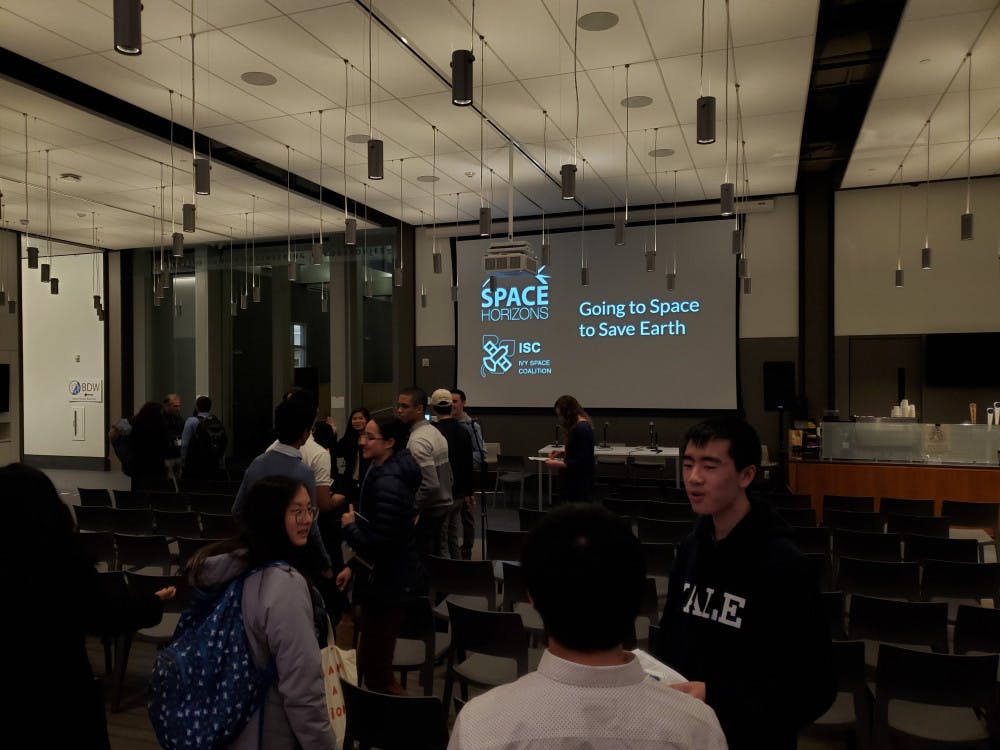This past weekend, experts from fields including Industrial Design, Aerospace Engineering, Theology and Planetary Science gathered with students in Hazeltine Commons. There, the 12th annual Space Horizons conference convened to contemplate how future journeys to space could help humanity save Earth.
“I started the conference out of frustration that the space business was being too conservative,” said Adjunct Associate Professor of Engineering and co-organizer of the event Rick Fleeter ’76 PhD ’81. Space enterprises, like NASA, were limiting their scope to focus on the things that they considered doable or achievable, he said. But, Fleeter recalled science writer Arthur Clarke’s notion that “the only way to really learn anything is just by trying to do the impossible,” Fleeter said.
This idea of defying the achievable and considering the impossible gave birth to the Space Horizons conference. “We input impossible questions and then we find … these people who work on them and then we find out that it’s actually possible,” Fleeter said.
Space Horizons diverged from the usual conference format by avoiding podium style lectures. Instead, students were able to approach a set of three tables, each with experts available to answer questions. This style sparked interesting dialogue, as participants were exposed to different ideas and new ways of thinking, said Michael Lye, a senior critic and NASA coordinator at the Rhode Island School of Design. “There is something really different in having the opportunity to go meet someone face to face and talk to them and get the conversation going,” he said.
The event included multiple forums such as “Off Planet Manufacturing,” “Investing in Human Habitats in Space” and “Risks of Replicating Earth Mistakes in Space.”
Phil Metzger, a planetary scientist at the University of Central Florida and a former NASA employee, presented the idea of transforming Earth through space technology. “Technologies that we develop for exploration missions are the same technologies that could support settlement beyond Earth, or establish industry on Earth in order to benefit Earth,” Metzger said. He explained that humans must look for solutions to their problems beyond their planet.
While Metzger mentioned that the “long-term vision” would be to create machines that would operate in space to benefit Earth, he acknowledged that there are many intermediary steps that must be taken before that vision can be reached. He listed these “stepping stones” as “using mining equipment to extract water and (using) that water as rocket fuel for space companies,” as well as extracting metals that could be manufactured to produce technologies such as giant antennas which could provide much higher data speeds. The potential of space also includes utilizing the unique properties of space — such as the lack of gravity — for manufacturing. But, technologies that operate more easily in space have to produce tangible value for them to be economically viable, he said.
The idea of using space technologies for different fields on Earth was a topic that also appeared in the keynote speech of Kimberly Arcand, visualization and emerging technology lead for NASA’s Chandra X-ray Observatory. She mentioned that her job is to “visualize the high energy universe such as exploding stars (and) black holes … (and) take data of the universe, visualize it and tell a story with that image.” These images may include a “2D image, 3D model, virtual reality application or a 3D print.” She also highlighted how the technologies used in telescopes like the Chandra Observatory have been “recycled” for use on Earth; whether it be in environmental monitoring, medicine or other domains — exemplifying how space technology is already serving an unexpected but necessary purpose on Earth.
Another topic of discussion was the long-duration human exploration missions and settlements beyond Earth. While the technical challenges of such missions and settlements are well known, experts mentioned that the psychological challenges of long-term space travel play a significant role in the viability of such missions. “A lot (of the) challenges to design for space (are) psychological. We might have to just stay in a habitat for a very long time. We have to see what happens in such situations,” Lye said. NASA has previously and is currently running simulations, such as the HI-SEAS Dome experiment on Earth, to test such scenarios, he added.
Jessica Newman, crewed spaceflight operations and training instructor at NASA, mentioned that the “technical” part of training for space travel is the easy part. Newman has witnessed how it takes astronauts a longer time to become accustomed to the unique set of soft skills, referred to as “Space Flight Resource Management,” which are needed to be successful in space. These skills include team interaction and reactions under pressure, skills which are key in missions.
With its wide array of offerings, the Space Horizons conference brought experts of many perspectives to one place — an experience Lye compared to browsing a library. “If I know exactly what I’m looking for and I pull that book out … I only get that information that I’m looking at. If I look around, I’ll see things. It’s the same with people here,” Lye said.
These kinds of events present opportunities for space researchers to “be influential (and) promote making life better for humans,” Newman said.





